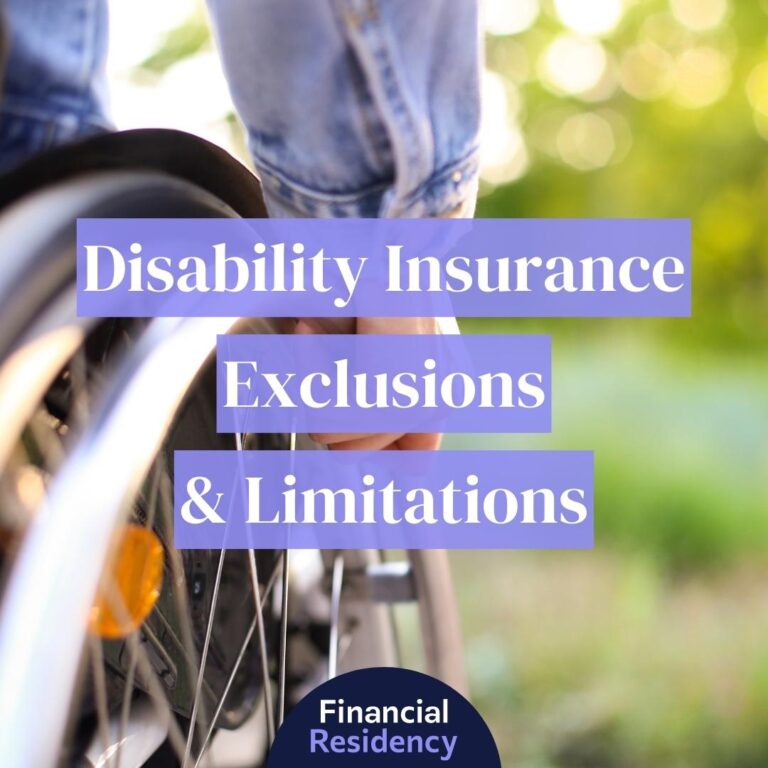Disability insurance provides income protection when an unexpected injury or illness affects your ability to perform the duties of your occupation. Short-term and long-term disability insurance covers you when you have a total disability. But what if you’re only partially disabled?
Traditional disability insurance might not provide full coverage in this scenario––leaving you with income gaps. A residual disability rider can help you access your maximum benefit should you be out of work for an extended period.
Understanding how disability insurance works can help you better prepare for the unexpected and decide if adding a residual disability insurance rider makes sense for you. Because when life happens, you’ll want to be ready.
What is a Residual Disability Rider?
Residual disability benefits can be added to your existing disability or life insurance policy. It provides coverage if you have a loss of earnings due to a partial disability. It’s not stand-alone insurance; it’s added to your base policy.
Residual disability riders are an important component of disability insurance coverage that provide benefits for individuals who experience partial or residual disabilities. Unlike a total disability, which completely inhibits a person from performing their job, a partial disability may allow you to keep working with limitations. These limitations may result in reduced hours, which is likely to affect your monthly income.
Residual disability benefits ensure you receive financial support if you experience a partial disability. This disability income can bridge the gap and maintain your standard of living.
Residual disability coverage is an essential consideration for individuals who work in professions where even partial disabilities can significantly impact their earning capacity. Medical professionals, particularly physicians, dentists, and small business owners, are uniquely vulnerable in this way because they are the experts in their workplace.
Insurance companies recognize that. By electing a residual disability rider, you can ensure you’ll receive financial support to cover the income gap caused by a partial disability. Reducing financial strain can give you more time and space to heal during your recovery period, so you can focus on what matters.
What is The Difference Between Residual Disability and Partial Disability?
Some insurance companies make a distinction between residual disability and partial disability. Partial disability covers an illness or injury that results in a diminished capacity to perform your job responsibilities or work full-time hours.
Partial disability pays out a portion of your total policy benefits. Residual disability covers the percentage of income you lose due to an illness or injury.
Let’s look at an example to illustrate the difference between residual disability and partial disability.
If you are partially disabled and unable to perform 50% of your job’s functions, you may be eligible for 50% of your policy’s monthly benefit amount until you are able to return to work or for up to 10 years after your claim.
The qualifying terms for residual disability benefits can vary between insurance carriers and policies, but residual disability generally provides coverage if you become disabled and return to work in a reduced capacity.
Not all insurance carriers differentiate between partial and residual disability, so it’s important to understand how your policy operates.
How Residual Disability Benefits Work
Residual disability insurance benefits are typically calculated based on the percentage of income lost due to partial disability.
For instance, if a person experiences a 50% loss of income, they may receive a benefit payment equal to 50% of their total disability monthly benefit. These benefits are usually paid every month until the age of 65, providing ongoing support as long as the partial disability impacts your working capacity.
Additionally, many residual disability benefit riders include recovery benefits, which assist individuals in transitioning back to full-time work.
These partial disability benefits may continue until your income reaches a specified percentage of your pre-disability income. The exact terms and requirements for residual disability benefits vary, so it is essential to review the policy definitions for specific details.
Qualifying for Residual Disability Benefits
You’ll be required to meet certain criteria outlined in your policy agreement to qualify for residual disability benefits.
These criteria typically include:
- Loss of income: The disability results in an income reduction
- Loss of duties: The disability prevents you from fulfilling substantial duties of your occupation
- Loss of time: The disability hinders you from working the same hours you worked prior to the partial disability
If you are partially disabled with a 50% income reduction, your residual disability coverage can replace up to 50% of your pre-disability income.
If your partial disability leads to more than a 75%-80% income reduction, you may receive 100% of their monthly total disability benefit amount.
It’s important to note that not all disability insurance policies automatically include residual disability coverage. Therefore, it’s crucial to thoroughly understand the specifics of your base policy.
We recommend all medical professionals consult with an insurance agent, broker, or qualified financial advisor to determine if adding this coverage is necessary.
Benefits of Having Residual Disability Coverage
Having residual disability coverage is a wise decision when it comes to protecting your income and financial stability. This optional rider provides more comprehensive benefits that enhance the coverage of a standard disability insurance policy.
Ensuring Income Stability Through Recovery or Prolonged Disability
One of the primary benefits of having residual disability coverage is the assurance of income stability. You may be unable to work at your full capacity in the unfortunate event that you are injured, ill, or disabled.
While standard disability insurance typically pays around 60% of your income, residual disability coverage replaces a larger percentage of your income.
By adding this optional rider, you can enjoy a higher level of financial protection, ensuring you can still meet your financial obligations in a variety of situations that may impact your ability to earn your full income.
This extra income can help cover essential expenses such as medical bills, everyday living costs, and ongoing care or therapy.
Transitioning Back to Full-Time Work
Residual disability coverage supports you as you transition back to full-time work, which is another significant advantage. In some cases, you may be able to return to work on a part-time basis while still collecting residual disability benefits.
This gradual transition can be crucial for your physical and emotional well-being, allowing you to adjust to your new circumstances without the added pressure of rushing back to full-time work before you’re ready.
During this transitional period, residual disability coverage can bridge the financial gap by continuing to supplement a portion of your income. This coverage allows you to focus on your recovery and gradually increase your workload until you are able to resume the full duties of your occupation.
Which Policies Include Residual Disability Coverage?
It’s crucial to have a clear understanding of what your disability insurance policy covers before electing any optional coverage. Some policies offer partial disability benefits if you are forced to work in a diminished capacity, but not all policies are created equally.
As such, it’s important to ensure that your policy provides benefits for residual disabilities.
If you’re unsure whether your disability insurance policy includes residual disability coverage, reach out to your agent or broker for clarification. They will be able to provide you with detailed information about your specific policy’s coverage. This information will guide you on whether or not residual disability benefits will need to be elected.
You can gain valuable insights into the extent of coverage provided by your policy and address any potential income gaps that may arise due to partial disability by having proactive discussions with your spouse and trusted financial advisors.
Not all disability insurance policies automatically include residual disability coverage. Therefore, it’s crucial to review your policy and consult with your insurance professional to ensure that you have the appropriate coverage for your specific needs.
Is a Residual Disability Rider Worth It?
Having a residual disability rider is crucial for medical professionals who depend on their income to meet their financial obligations. This rider provides benefits for partial or residual disabilities, ensuring that you are financially protected even if you can only work part-time or have reduced hours due to an injury, illness, or disability.
The benefits are calculated based on the percentage of lost income, which can help maintain until you reach retirement age. Some policies also offer recovery benefits to ease the transition back to full-time work, which can be an essential safety net.
It is important to review your policy and work with your agent or broker to ensure that you have the necessary coverage for partial or residual disabilities.
Other Riders Worth Considering:
Everyone has different needs to consider when building out their ideal disability income insurance coverage. In addition to the residual disability riders, we recommend you consider electing the following riders to your base policy:
- Catastrophic Disability Benefit Rider: Provides up to 100% income replacement if you are permanently disabled
- Waiver of Premium Rider: Ensures the insurance carrier covers, or waives, premium payments in the event the policyholder is unable to work or pay for premiums
- Cost-of-living Adjustment Rider (COLA): Increases your monthly benefit to keep up with the rate of inflation measured by the Consumer Price Index
- Future Increase Option Rider: Reserves the right for policyholders to increase coverage without undergoing additional medical underwriting, also known as Future Purchase Option or Future Increase Rider
- Student Loan Protection: Adds to your monthly benefit to compensate for student loan payments if you become disabled



